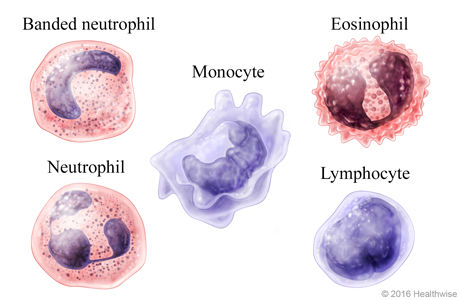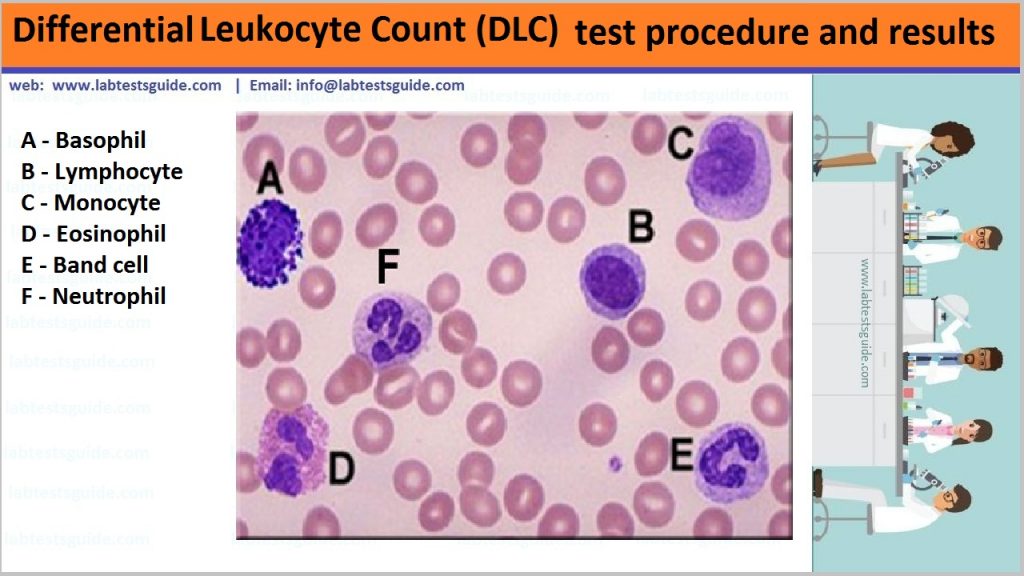Introduction:
What is DLC?
Blood is made up of different types of cells which are suspended in a fluid called plasma. These include erythrocytes or red blood cells, leukocytes or white blood cells, and platelets. Blood cells are produced by the hematopoietic cells in bone marrow and are then released into circulation. RBCs carry oxygen to the tissues, platelets help in blood clotting at a site of injury, and leukocytes form an integral part of the immune system of the body.
Leukocytes or white blood cells (WBCs) are blood cells which form an integral part of the immune system of the body. WBCs are responsible for protecting you from infections, allergies and diseases. There are five types of WBCs with each of them having different functions.
- Basophils
- Eosinophils
- Neutrophils
- Monocytes
- Lymphocytes
- 1. Neutrophils: Under normal conditions, the number of neutrophils present is higher than any other type of WBCs.. They provide protection against pathogens, mostly bacteria and sometimes fungi. Neutrophils engulf the pathogens completely and digest them (the process is called phagocytosis). They are usually associated with acute or short-term infections.
- 2. Eosinophils: Eosinophils are WBCs that are primarily responsible to fight parasitic infections. They are also involved in allergic reactions and regulation of the extent of immune response.
- 3. Basophils: Basophils are WBCs which are present in the lowest numbers in circulation. They are considered to play an important role in allergic response.
[Neutrophils, eosinophils, and basophils are together classified as granulocytes. Granulocytes are the WBCs which contain granules present in their cytoplasm. These granules secrete chemicals during immune response.]
- 4. Monocytes: Monocytes are WBCs which are also involved in protection against infectious pathogens by phagocytosis like neutrophils. However, monocytes are more commonly associated with chronic or long-term infections.
- 5. Lymphocytes: These are specialized WBCs which are responsible for recognizing and neutralizing foreign (non-self) cells and cancer cells in the body. Lymphocytes are of three types, all of which are differentiated from a common type of lymphocyte progenitor cell:
· T cells or T lymphocytes are produced in the bone marrow and mature in the thymus gland. They are responsible for differentiating between self and non-self cells of the body. T cells are also responsible for the initiation and extent of immune response, and targeted destruction of cancer cells and virus.
· B cells or B lymphocytes are control acquired immunity by producing antibodies against antigens found on foreign cells and pathogens like bacteria and viruses.
· Natural killer cells or NK cells destroy all foreign cells tagged by antibodies, cancer cells and virus-infected cells by phagocytosis.
Depending on various factors like age, gender, health condition, environmental factors, etc., varying amounts of different types of WBCs circulate in the blood. The bone marrow increases production of WBCs in response to an infection or inflammation anywhere in the body, which are then called to the site by a series of chemical signals, where they work to treat the condition. Depending on the condition, the count of one or more types of WBCs remains high in the blood. Once the condition subsides, WBC production by the bone marrow decreases and their count in circulation falls back to normal levels. Elevated amount of one or more types of leukocytes for a long time may be an indication of a chronic condition that is not resolving naturally and might need urgent attention.
- Apart from an infection or inflammation, WBC count in blood can also be affected by other conditions like disorders of the immune system, autoimmune conditions, cancer, etc. One or more types of WBC count may be higher or lower than normal in these cases.
- Differential Leukocyte Count Test serves as an indication of a condition affecting the body. Further tests are performed to confirm a particular condition and direct treatment.
Differential Leukocyte Count Test or blood differential test measures the total number of all the WBCs in blood.
Each type of WBCs has a unique function and hence changes in their levels may indicate specific health conditions. For example, raised eosinophils are usually an indication of allergies.
Why is a DLC performed?
- This is done to check for conditions such as anaemia, infections, autoimmune disorders and leukaemia. Symptoms that could relate to inappropriate levels of WBCs in the body are as follows:
- Weight loss
- Fatigue
- Bruising
- Fever
- Body aches
- Chills
- Headache
- The Differential Leukocyte Count Test is performed:
- As a part of Complete Blood Count (CBC) Test in regular health checkups.
- As follow up test in case of abnormal CBC results
- To help diagnose infections and inflammation
- To help diagnose conditions that decrease WBC count like bone marrow disorders
- To monitor bone marrow function
- To monitor chemotherapy treatment
How is a blood differential test performed?
A laboratory specialist puts a drop of blood from your sample on a clear glass slide and smears it to spread the blood around. Then, they stain the blood smear with a dye that helps to differentiate the types of white blood cells in the sample.
The lab specialist then counts the number of each white blood cell type.
What are the complications associated with a blood differential test?
The risk of complications from having blood drawn is very slight. Some people experience mild pain or dizziness.
After the test, a bruise, slight bleeding, an infection, or a hematoma (a blood-filled bump under your skin) might develop at the puncture site.
What do DLC results mean?
Normal results:
The results for the DLC are given in the terms of percentages. The normal ranges for the different WBCs are as follows:
- Basophils: 0.5% – 1%
- Eosinophils: 1% – 4%
- Neutrophils: 40% – 60%
- Monocytes: 2% – 8%
- Lymphocytes: 20% – 40%
Abnormal results:
Abnormal WBCs values could be a sign of an underlying health condition. Sometimes, an increase in the levels of one type of WBC can lead to a decrease in the levels of another type.usually, a rise in WBCs is due to an inflammatory condition, an immune response to infection or a tumour.
The following table details the factors associated with the change in the levels of different WBCs:
| Types of cells | Factors associated with increased levels | Factors associated with decreased levels | |
| Neutrophils | TraumaEclampsia (coma or seizures in a pregnant woman)Rheumatoid arthritisGoutMyelocytic leukemiaThyroiditis (a thyroid disease)Acute stressRheumatic fever (caused by streptococcus bacteria)Acute infection | ChemotherapyAplastic anemiaRadiation therapyInfluenzaSever bacterial infectionViral infection | |
| Lymphocytes | Infectious hepatitisMono (infectious mononucleosis, a viral infection leading to sore throat, fever, etc.)Multiple myelomaLymphocytic leukemiaChronic bacterial infectionViral infection | HIV/AIDSChemotherapyRadiation therapy or exposureLeukemiaSepsisUse of steroids | |
| Monocytes | Parasitic infectionLeukemiaTuberculosisChronic inflammatory diseaseViral infection such as mumps and measles | None known | |
| Eosinophils | Allergic reaction Addison’s diseaseCancerChronic myelogenous syndromeCollagen vascular diseaseParasitic infection | None known | |
| Basophils | Allergic reactionCollagen vascular diseaseChickenpoxAfter spenectomyMyeloproliferatiive diseases ( agroup of disorders with bone marrow)Chronic myelogenous leukaemia | Severe injuryAcute infectionCancer | |
The levels of WBCs can vary from person to person depending on age, gender, and health conditions. WBC levels also vary during pregnancy.
Samsung Galaxy M15 5G (Blue Topaz,4GB RAM,128GB Storage)| 50MP Triple Cam| 6000mAh Battery| MediaTek Dimensity 6100+ | Super AMOLED Display| Add to Cart and Get Travel Adapter at No Cost
₹13,299.00 (as of April 19, 2024 08:30 GMT +00:00 - More infoProduct prices and availability are accurate as of the date/time indicated and are subject to change. Any price and availability information displayed on [relevant Amazon Site(s), as applicable] at the time of purchase will apply to the purchase of this product.)Redmi 13C (Starfrost White, 4GB RAM, 128GB Storage) | Powered by 4G MediaTek Helio G85 | 90Hz Display | 50MP AI Triple Camera
₹7,699.00 (as of April 19, 2024 08:30 GMT +00:00 - More infoProduct prices and availability are accurate as of the date/time indicated and are subject to change. Any price and availability information displayed on [relevant Amazon Site(s), as applicable] at the time of purchase will apply to the purchase of this product.)realme NARZO 70 Pro 5G (Glass Green, 8GB RAM,128GB Storage) Dimensity 7050 5G Chipset | Horizon Glass Design | Segment 1st Flagship Sony IMX890 OIS Camera
₹19,999.00 (as of April 19, 2024 08:30 GMT +00:00 - More infoProduct prices and availability are accurate as of the date/time indicated and are subject to change. Any price and availability information displayed on [relevant Amazon Site(s), as applicable] at the time of purchase will apply to the purchase of this product.)iQOO Z9 5G (Brushed Green, 8GB RAM, 128GB Storage) | Dimensity 7200 5G Processor | Sony IMX882 OIS Camera | 120Hz AMOLED with 1800 nits Local Peak Brightness | 44W Charger in The Box
₹19,999.00 (as of April 19, 2024 08:30 GMT +00:00 - More infoProduct prices and availability are accurate as of the date/time indicated and are subject to change. Any price and availability information displayed on [relevant Amazon Site(s), as applicable] at the time of purchase will apply to the purchase of this product.)Oneplus Nord CE4 (Celadon Marble, 8GB RAM, 128GB Storage)
₹24,999.00 (as of April 19, 2024 08:30 GMT +00:00 - More infoProduct prices and availability are accurate as of the date/time indicated and are subject to change. Any price and availability information displayed on [relevant Amazon Site(s), as applicable] at the time of purchase will apply to the purchase of this product.)Oneplus Nord CE4 (Dark Chrome, 8GB RAM, 256GB Storage)
₹26,999.00 (as of April 19, 2024 08:30 GMT +00:00 - More infoProduct prices and availability are accurate as of the date/time indicated and are subject to change. Any price and availability information displayed on [relevant Amazon Site(s), as applicable] at the time of purchase will apply to the purchase of this product.)iQOO Neo9 Pro 5G (Fiery Red, 8GB RAM, 256GB Storage) | Snapdragon 8 Gen 2 Processor | Supercomputing Chip Q1 | Flagship Level Sony IMX920 Camera
₹36,999.00 (as of April 19, 2024 08:30 GMT +00:00 - More infoProduct prices and availability are accurate as of the date/time indicated and are subject to change. Any price and availability information displayed on [relevant Amazon Site(s), as applicable] at the time of purchase will apply to the purchase of this product.)Redmi Note 13 5G (Arctic White, 6GB RAM, 128GB Storage) | 5G Ready | 120Hz Bezel-Less AMOLED | 7.mm Slimmest Note Ever | 108MP Pro-Grade Camera
₹17,999.00 (as of April 19, 2024 08:30 GMT +00:00 - More infoProduct prices and availability are accurate as of the date/time indicated and are subject to change. Any price and availability information displayed on [relevant Amazon Site(s), as applicable] at the time of purchase will apply to the purchase of this product.)Redmi 13C 5G (Startrail Silver, 4GB RAM, 128GB Storage) | MediaTek Dimensity 6100+ 5G | 90Hz Display
₹10,499.00 (as of April 19, 2024 08:30 GMT +00:00 - More infoProduct prices and availability are accurate as of the date/time indicated and are subject to change. Any price and availability information displayed on [relevant Amazon Site(s), as applicable] at the time of purchase will apply to the purchase of this product.)Redmi 13C (Stardust Black, 4GB RAM, 128GB Storage) | Powered by 4G Mediatek Helio G85 | 90Hz Display | 50MP AI Triple Camera
₹7,699.00 (as of April 19, 2024 08:30 GMT +00:00 - More infoProduct prices and availability are accurate as of the date/time indicated and are subject to change. Any price and availability information displayed on [relevant Amazon Site(s), as applicable] at the time of purchase will apply to the purchase of this product.)Mamaearth Aloe Vera Gel - 300ml | For Face, with Pure Aloe Vera & Vitamin E for Skin and Hair | All Skin Type
₹270.00 (as of April 19, 2024 08:30 GMT +00:00 - More infoProduct prices and availability are accurate as of the date/time indicated and are subject to change. Any price and availability information displayed on [relevant Amazon Site(s), as applicable] at the time of purchase will apply to the purchase of this product.)The Derma Co 1% Hyaluronic Long Lasting Sunscreen SPF 50 PA++++ with Hyaluronic Acid & Vitamin E for Broad Spectrum Protection- 50 g | 6 Hrs. Sun Protection | Water & Sweat Resistant | No Reapplication Needed
₹531.00 (as of April 19, 2024 08:30 GMT +00:00 - More infoProduct prices and availability are accurate as of the date/time indicated and are subject to change. Any price and availability information displayed on [relevant Amazon Site(s), as applicable] at the time of purchase will apply to the purchase of this product.)GoSriKi Women's Rayon Blend Straight Printed Kurta with Palazzo
₹469.00 (as of April 19, 2024 08:30 GMT +00:00 - More infoProduct prices and availability are accurate as of the date/time indicated and are subject to change. Any price and availability information displayed on [relevant Amazon Site(s), as applicable] at the time of purchase will apply to the purchase of this product.)Lux Cozi Men's Regular Fit Polo Neck Half Sleeve Solid Casual T-Shirt | Polo T-Shirt for Men
Now retrieving the price.
(as of April 19, 2024 08:30 GMT +00:00 - More infoProduct prices and availability are accurate as of the date/time indicated and are subject to change. Any price and availability information displayed on [relevant Amazon Site(s), as applicable] at the time of purchase will apply to the purchase of this product.)





















